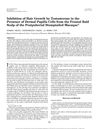Search
forLearn
5 / 16 resultslearn Stem Cell Factor
learn Osteopontin
signaling protein that, when suppressed, may grow hair by reducing inflammation and stem cell loss
learn Neem Oil
natural substance from Neem tree with medicinal and pesticidal properties
learn Overview
Research
5 / 1000+ resultsresearch Interaction Between Dermal Papilla Cells and Follicular Epithelial Cells In Vitro: Effect of Androgen
Testosterone helps beard and axillary hair cells grow by releasing growth factors from dermal papilla cells.
research Role of Androgen in Mesenchymal Epithelial Interactions in Human Hair Follicle
Androgens promote beard growth but cause hair loss in androgenetic alopecia, with TGF-β1 as a potential treatment target.
research Interaction Between Dermal Papilla Cells and Follicular Epithelial Cells In Vitro: Effect of Androgen
Testosterone increases hair follicle cell growth when beard or axillary skin cells are present together.

research Inhibition of Hair Growth by Testosterone in the Presence of Dermal Papilla Cells from the Frontal Bald Scalp of the Postpubertal Stumptailed Macaque
Testosterone can slow down hair growth when combined with certain cells from bald scalps, and this effect can be blocked by an androgen receptor blocker.
research Mechanism of Action of Androgen in Hair Follicles
Testosterone affects hair follicles differently across body sites, with beard hair follicles showing more activity of a specific enzyme and presence of androgen receptors compared to scalp hair.
Community Join
5 / 1000+ resultscommunity My Theory Of Androgenic Alopecia
Hair loss is linked to cellular physiology and the IGF-1 to TGF-B1 ratio, not just androgen sensitivity. The theory lacks evidence, while finasteride and minoxidil are effective treatments.

community Compressed part of research of theory of androgenic/anabolitic balance. AGA h-responders analytic. Theory of physio-metabolitic method of anti AGA treatment
The treatment for androgenetic alopecia involves using finasteride and minoxidil with intense exercise and cold exposure to boost metabolism and reduce androgenic effects, potentially leading to hair regrowth. This approach may activate biological pathways for improved hair and overall health.
community After 11 Years On Finasteride, Unfortunately, Hair Is Starting To Thin Again. Does Hair Simply Get More Sensitive To DHT As You Age?
After 11 years on Finasteride, a user's hair is thinning again, suggesting hair may become more sensitive to DHT with age. They plan to introduce Dutasteride once a week, as they cannot tolerate Minoxidil.
community Bee venom better than minoxidil?
Bee venom at 0.001% concentration was more effective than 2% minoxidil in promoting hair growth in mice, possibly due to increased growth factors and reduced inflammation. Caution is advised due to potential allergic reactions and the reliance on animal data.
community Physio-metabolic method of treating androgenic alopecia. Cold receptors. The relationship between DHT, cold receptors, minoxidil and antiandrogens.
A method for treating androgenic alopecia using minoxidil, antiandrogens, exercise, and cold exposure to promote hair growth. Environmental factors and lifestyle changes, like diet and exercise, can improve treatment effectiveness.